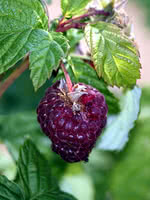Mon-Fri 9am - 5pm Mountain time
Wyoming Raspberry vs Bilberry
Rubus x Wyoming
Vaccinium myrtillus
NOT AVAILABLE THIS SEASON - MIGHT RETURN
CUSTOM GROW
Wyoming Raspberry is a blackberry/raspberry hybrid. It is a vigorous grower, with floricane canes reaching up to 8 feet, which you must support if they are heavily laden with fruit.
The fruit is a deep purple to black drupe, with a flavour between blackberry and raspberry.
It is more cold hardy than other black raspberry cultivars, suitable to cold hardiness zone 3a. Wyoming Black Raspberry is non-suckering, making it suitable for the small home garden.
The Wyoming Raspberry is a fast-growing floricane. This means that raspberries will not grow on canes the year they first grow. The mature canes they do grow on, however, produce more berries than primocane varieties.
Bilberry is a native perennial shrub valued for its small, blue-black berries that ripen in mid to late summer. The berries resemble blueberries but have a richer, more tart, and intense flavor. They have long been used for fresh eating, baking, and preserves, while also providing food for birds and mammals. In spring, its delicate pinkish flowers attract bees and other pollinators.
Growing low to the ground, Bilberry forms spreading colonies that create dense understory cover. This growth habit provides food and shelter for wildlife, and its foliage adds seasonal interest by turning red to purple in autumn. With its adaptability and ecological benefits, Bilberry is well-suited for naturalization, ecological restoration, and pollinator gardens.
Wyoming Raspberry Quick Facts
Bilberry Quick Facts
Toxicity: leaves may be unsafe in high doses

